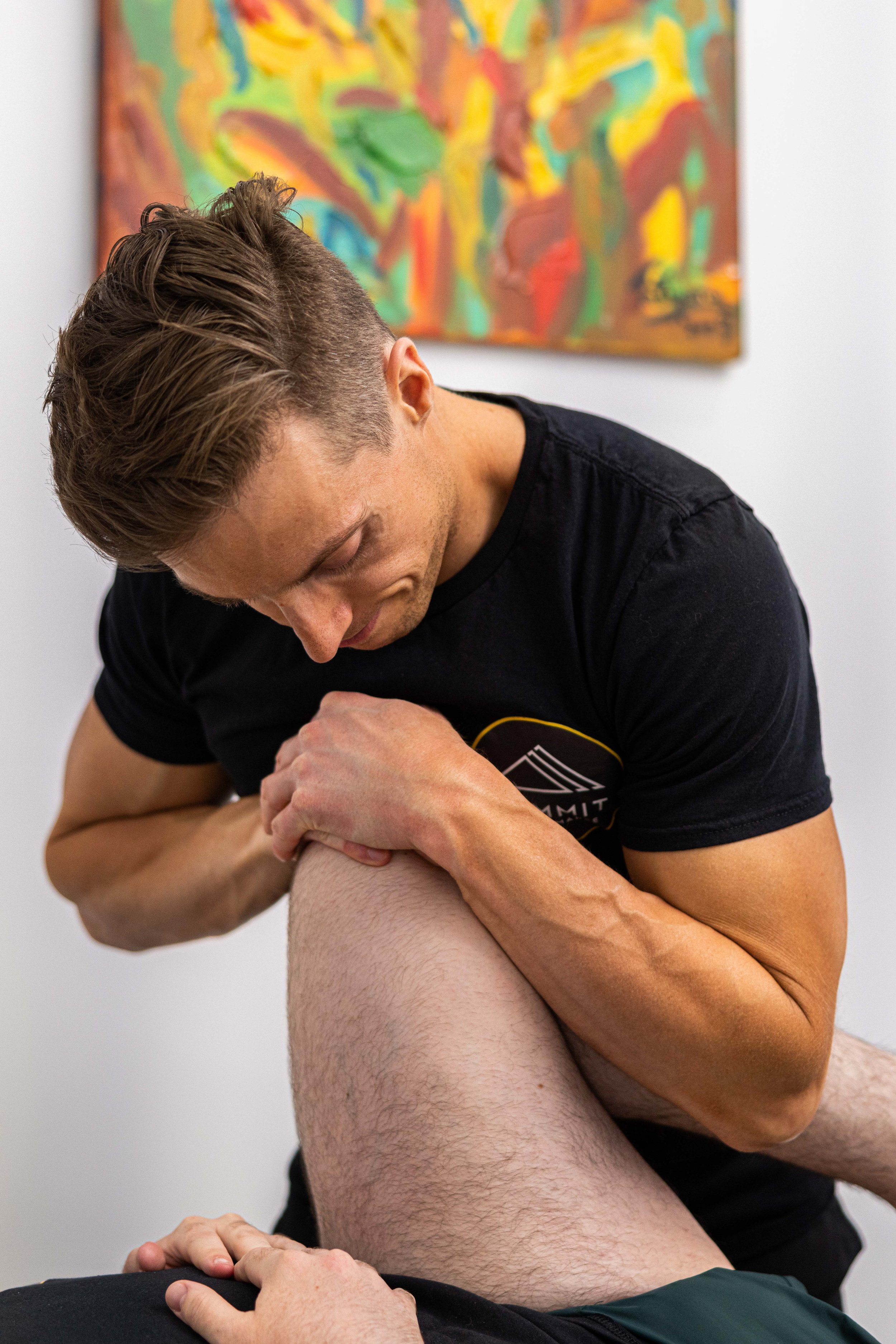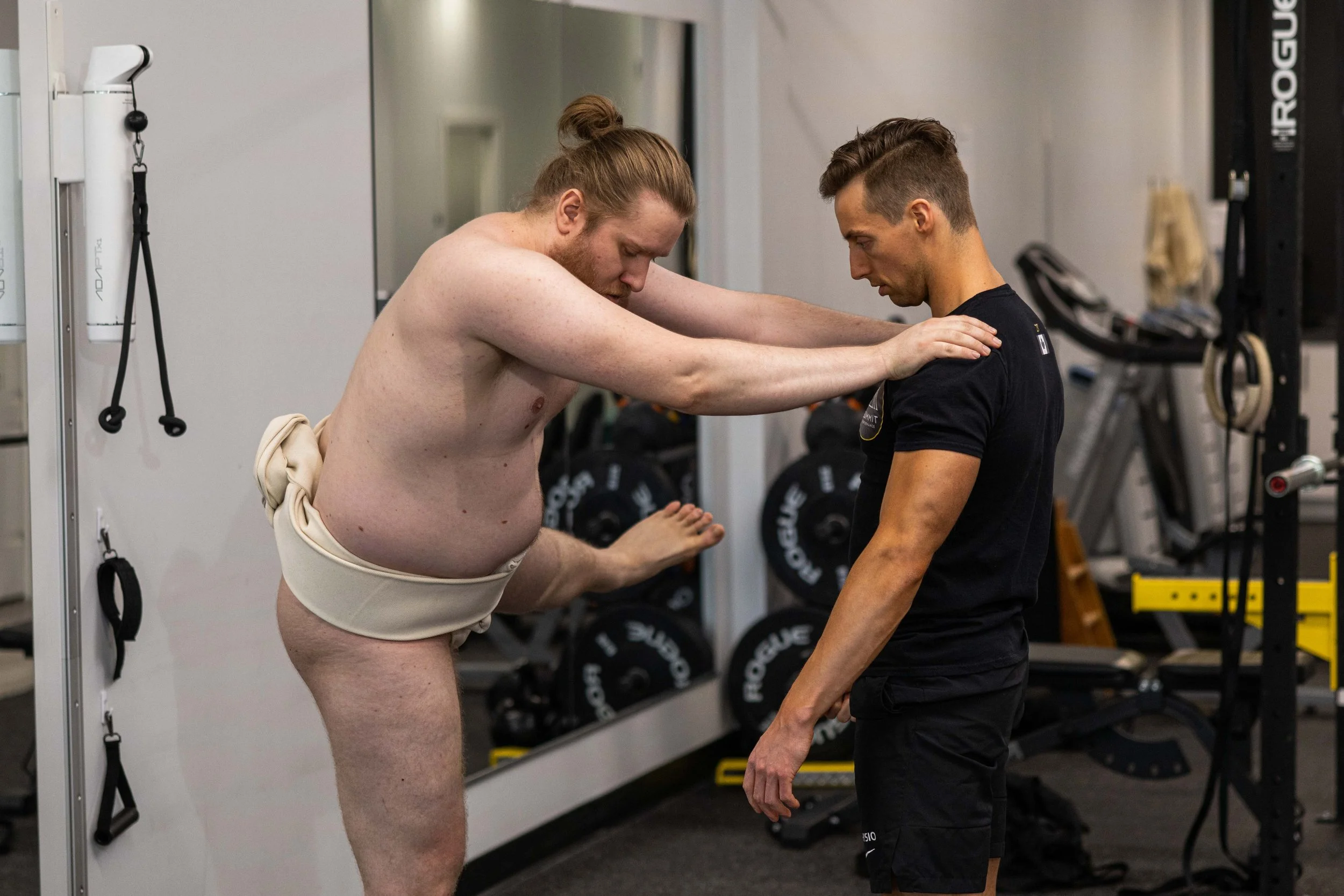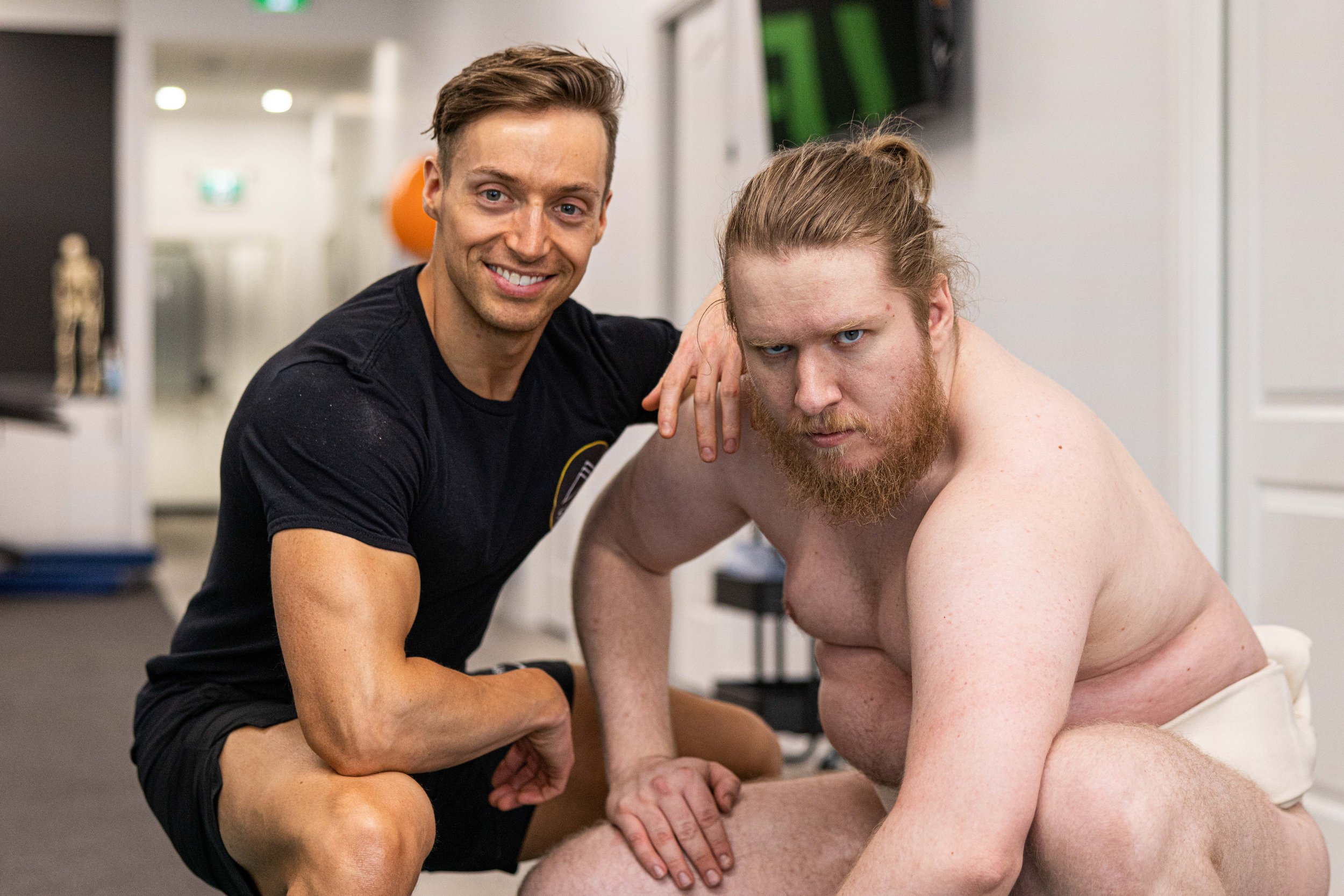Change your relationship with your physiotherapist.
Stop waiting for pain; private, clinician‑led maintenance to stay training and performing at your best.
What preventative physiotherapy looks like
Regular, clinician‑led maintenance turns guesswork into clear decisions — brief objective checks, targeted tune‑ups, and short filmed programs that slot into your training week so you stay healthy and progress consistently.
Three core elements:
Baseline snapshots — short, sport‑relevant tests we co‑design with you to track strength, power, and movement markers that matter to your sport.
Tune‑ups and time‑banked hours — brief in‑person visits at your location plus short remote check‑ins; we use your monthly hours how you need them.
Rehab Blueprints (filmed take‑homes) — 3–6 short clips and written cues updated after every visit so you practice the exact drills we prescribe.
Want to see how this fits your training? Request a bespoke Athlete Package
Most solo athletes miss the testing that actually prevents setbacks
When you train independently, testing is often optional, inconsistent, or focused on what a team needs. Small, untracked deficits build up unnoticed and show up as unexplained dips in performance or as injuries you then have to rehab.
This means:
You don’t get regular baseline data that matches your sport or goals.
Coaches and trainers might track your training loads and volume but not the specific strength or movement markers that protect you.
When things go wrong you’re left rehabbing instead of preventing, costing time and confidence.
You may have training metrics you want tracked, but you aren’t getting that information.
With Summit you get private clinician‑led baseline testing and monthly tune‑ups designed around your priorities so you see the signal before it becomes a problem.
Dedicated Athlete Service — preventative maintenance tailored to solo competitors
Join our roster of proactive unique solo athletes taking care of their health with our private athlete care service
What’s Included
Deliverables:
Recurring baseline testing — sport‑specific, clinician‑designed snapshots to track strength, power, mobility, and other relevant metrics over time.
Clinician‑led check‑ins (≈55 min) — focused hands‑on visits at your location or telehealth tune‑ups when travel isn’t required.
Objective snapshot & progress note — portable testing (VALD or simplified field protocols), recorded metrics, and an easy‑to‑read progress summary after each visit.
Rehab Blueprint (filmed take‑home) — 3–6 short exercise clips with written cues, progress history, and clear practice goals.
Delivery service & continuity — clinician travel logistics handled, monthly metric summaries, and short remote check‑ins to keep training decisions evidence‑based.
Optional adjuncts (clinically indicated) — PowerDot setup, dry needling, or other add‑ons; all included in the bespoke proposal if recommended.
These are sample deliverables; each Athlete Package is custom quoted and adjusted to your goals, schedule, and location.
Private Athlete Service Inquiry Form
Typical cadence — how clinician time is scheduled around your season
Cadence describes how we allocate clinician hours across testing, on‑site visits, and remote checks to match your training phase. These are sample approaches to help you picture how clinician support fits into a real training month — every package is custom quoted.
Cadence explained
Brief checks & Baselines: short baseline snapshots to track key markers (55 minutes).
Tune‑ups: focused 55‑minute on‑site visits to address deficits, load management, or hands‑on treatment.
Remote touchpoints: video check‑ins and metric summaries to steer training between visits.
Example teaser (see full samples below)
Maintenance rhythm: 1 on‑site tune‑up + 1 snapshot; 3–4 total hours/month.
Peak block rhythm: 2 on‑site tune‑ups + 2 snapshots; 6–8 total hours/month.
See full sample cadences and real examples
These are demonstrative only — we’ll quote a bespoke cadence based on your goals, location, and season.
Each athlete’s package is custom sized (for example one athlete might take 4 hours a month; another 10. We design the time, frequency, and mix of in‑person vs remote touches to suit you.
Sample month cadences
Maintenance Month (steady training)
Hours allocated: 4 hours total
On‑site visits: 1 × 55‑minute tune‑up at your location
Testing frequency: 1 baseline snapshot 55-minute to start the month
At‑home program: 3 filmed Rehab Blueprint exercises with clear at home implementation plan
Why: Keeps metrics visible and fixes small deficits early so training progresses uninterrupted.
Sample cadences are demonstrative only — every package is custom quoted.
Heavy Training Block (in‑season)
Hours allocated: 8 hours total
On‑site visits: 2 × 55‑minute tune‑ups (every 2 weeks)
Testing frequency: 2 baseline snapshots (start and end of‑month)
At‑home program: 4–6 targeted drills, daily short activation routine
Why: Increased touchpoints catch accumulation and guide load management during intense training.
Competition Taper (pre‑event)
Hours allocated: 6 hours total (compressed over 2–3 weeks)
On‑site visits: 2 × focused visits for recovery, soft tissue work & mobility in advance of competition
Testing frequency: 1 targeted snapshot focused on symmetry and readiness
At‑home program: Short pre‑game activation and recovery cues; filmed warm‑up
Why: Fine‑tunes readiness, reduces risk of late‑stage flare‑ups, and preserves freshness for competition.
Want a sample cadence tailored to your season?
A real example — bespoke testing and care in practice
Regular snapshots and short tune‑ups let him confirm his gym work was compounding, avoid flare‑ups, and finish the season injury free.
Client:
24 year old solo competitive athlete came to us frustrated that their coach isn’t performing baseline testing of his performance, leaving him feeling like he missed key deficits. We co‑designed a short baseline battery that mattered to their sport, used objective snapshots to guide weekly training choices, and provided short filmed exercises and targeted stim sessions. Over the season they avoided a training plateau and competed with more confidence.
The plan we agreed on
Monthly baseline snapshot to track strength, power, and movement markers the athlete cared about.
One 55‑minute tune‑up session each month for hands‑on work, targeted activation, or recovery strategies.
Ongoing Rehab Blueprints (3–6 short filmed clips) updated as needed so the athlete practiced the exact drills we prescribed.
Coach/athlete data sharing only when the athlete wanted the coach involved.
Practical elements and schedule
Baseline testing: objective checks each month using portable range of motion measurement, dynamometry and simple movement screens; each snapshot took 55 minutes.
Tune‑up visit: 55 minutes focused on the most important limiter that month — activation work with PowerDot, mobility and load‑management, or technique tweaks filmed for at‑home practice.
Between visits: the athlete used 2–3 short filmed exercises from their Rehab Blueprint, 3–4 times per week.
Data review: after each baseline we sent a one‑page snapshot showing change from the prior month and one clear recommendation (maintain, progress, or ease off).
What we tracked and why it mattered
Strength symmetry and single‑leg power to catch early imbalances.
Movement quality on sport‑specific tasks to reduce injury risk.
Recovery markers and perceived load to prevent training accumulation from turning into breakdown. These measures let us see the signal in the noise — confirming when training was compounding positively even before big changes showed up in competition performance.
Outcomes the athlete experienced
Objective confirmation that gym work and sport practice were combining positively despite slow visible change.
Fewer unexpected flare‑ups during heavy training blocks because small deficits were caught early.
Increased confidence and better training choices because data and short videos removed doubt about what to do each week.
One season without a missed competition day that previously would have been at risk.
Why this approach worked
Regular baseline testing turned vague feelings into clear metrics so decisions were evidence‑based.
Monthly tune‑ups prevented small issues from becoming large problems while keeping interventions time‑efficient.
Personalized testing and filmed take‑homes made the plan feel tailored and easy to follow, not generic.
Baseline testing done your way
Many athletes either never get consistent baseline testing or they’re given a one‑size‑fits‑all battery that measures what the coach needs — not what matters to the athlete. That leaves gaps in what we can track and build from.
Our Approach:
We co‑design a baseline battery with you that measures the things you care about (strength symmetry, power, jump mechanics, movement quality, or sport‑specific tasks).
Baselines are evergreen: we repeat them at agreed intervals and after big training blocks so progress is meaningful and actionable.
We make the data useful: clear, simple snapshots and thresholds you can understand and use to guide training or rest.
This is about giving you control of your data and the freedom to test what actually helps your performance.
Tools that back your bespoke plan
We pick tools based on your goals and the baseline battery we design together — objective testing and simple daily tools that make your training safer and more efficient.
Featured tools
Hotel Card (Rehab Blueprint) — filmed, private exercise overviews that we update for you
VALD & portable dynamometry — objective strength and power snapshots you can track over time
PowerDot NMES — targeted stimulation to help an inhibited muscle fire or to speed recovery after heavy sessions
Other options we include selectively: dry needling, on‑site testing, mobility tools, travel kit for clinics or on‑site visits.
VALD in practice — a sample use case
VALD Dynamo gives us objective strength and ROM snapshots we use to tune training decisions across a season
Athlete profile: solo middle‑distance runner experiencing unexplained drop in 3k race pace.
Baseline snapshot: VALD test shows a 12% hip extension asymmetry and 6° reduced hip flexion ROM on the left compared to the right.
Clinical decision: we prioritized targeted mobility drills and unilateral force work, shifted some gym loading to reduce asymmetry, and added a weekly 55‑minute on‑site tune‑up for hands‑on correction.
Outcome (4 weeks): hip ROM restored to within 2° of the affected side and symmetry improved to under 6%, training load increased safely, and athlete reported restored race feel in subsequent time trials.
We include VALD snapshots in recurring baseline testing so you get both strength and ROM data to guide practical, measurable changes rather than guessing.
Want VALD snapshots included in your Athlete Blueprint? Request a bespoke Athlete Package
How it works — bespoke packages designed around your season and schedule
Every Athlete Package is custom quoted so you receive the exact hours, testing, travel, and access you need rather than a one‑size‑fits‑all plan.
Step 1 Tell us where and what you need
Submit a brief inquiry or book a 20–30 minute discovery call so we can understand your goals, training calendar, and travel requirements.
Step 2 We return a clear proposal (24–48 hours)
single all‑in quote
clinician hours,
baseline testing frequency,
travel logistics
equipment needs
recommended cadence
Step 3 Blueprint and scheduling after deposit
We deliver an Athlete Blueprint that lists baseline tests, visit cadence, kit to bring, and a provisional schedule.
Step 4 Delivery and continuous reporting
Clinician travels to your location for scheduled visits, runs baseline snapshots on site, issues filmed Rehab Blueprints after visits, and sends monthly metric summaries with clear recommendations.
Operational notes
Lead times: local bookings 2–3 weeks; provincial or national 4–8 weeks.
Travel: included in the bespoke quote; provide access and venue details at booking.
Changes: reschedules available up to 72 hours; late changes may incur travel fees.
Privacy: your data and Rehab Blueprints are private and shared only between Summit Performance and the client
We do not publish standard pricing — each package is custom. Start with a one‑month trial of your agreed hours so we can validate cadence and outcomes before committing longer term. You’ll receive a written proposal and clear cancellation/adjustment terms with every quote.
Practical questions athletes ask
-
Hours are pooled each month and scheduled with you; on‑site visits include travel windows and are agreed up front.
-
Yes — we bring portable testing and the travel kit for on‑site baselines; we coordinate timing around training and competitions.
-
We decide together; many athletes prefer a pre‑season baseline and periodic snapshots after major training blocks or before important events
-
Only if you ask us to share it; we work with coaches on consented data sharing when helpful.
-
Packages are flexible; hours can be reallocated or adjusted with notice and documented in your monthly summary.
-
Item description
Still have a question? Contact us about Athlete Packages









